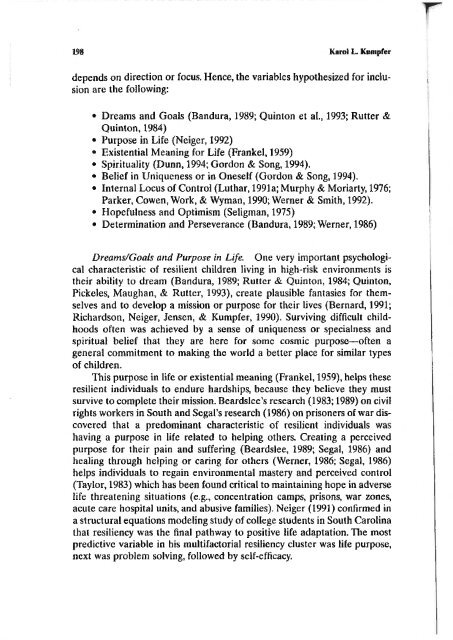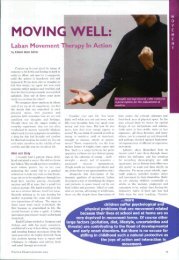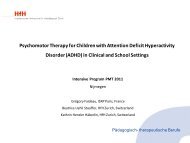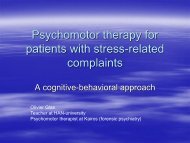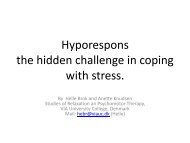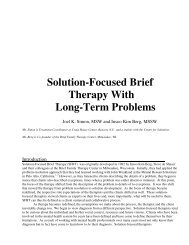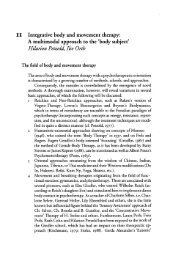Factors and Processes Contributing to Resilience
Factors and Processes Contributing to Resilience
Factors and Processes Contributing to Resilience
Create successful ePaper yourself
Turn your PDF publications into a flip-book with our unique Google optimized e-Paper software.
198 K•rol L. Kumpfer<br />
depends on direction or focus. Hence, the variables hypothesized for inclusion<br />
are the following:<br />
• Dreams <strong>and</strong> Goals (B<strong>and</strong>ura, 1989; Quin<strong>to</strong>n et al., 1993; Rutter &<br />
Quin<strong>to</strong>n, 1984)<br />
• Purpose in Life (Neiger, 1992)<br />
• Existential Meaning for Life (Frankel, 1959)<br />
• Spirituality (Dunn, 1994; Gordon & Song, 1994).<br />
• Belief in Uniqueness or in Oneself (Gordon & Song, 1994).<br />
• lnternal Locus of Control (Luthar, 1991a; Murphy & Moriarty, 1976;<br />
Parker, Cowen, Work, & Wyman, 1990; Werner & Smith, 1992).<br />
• Hopefulness <strong>and</strong> Optimism (Seligman, 1975)<br />
• Determination <strong>and</strong> Perseverance (B<strong>and</strong>ura, 1989; Werner, 1986)<br />
Dreams!Goals <strong>and</strong> Purpose in Life. One very important psychological<br />
characteristic of resilient children living in high-risk environments is<br />
their ability <strong>to</strong> dream (B<strong>and</strong>ura, 1989; Rutter & Quin<strong>to</strong>n, 1984; Quin<strong>to</strong>n,<br />
Pickeles, Maughan, & Rutter, 1993), create plausible fantasies for themse]ves<br />
<strong>and</strong> <strong>to</strong> deveJop a mission or purpose for their lives (Bernard, 1991;<br />
Richardson, Neiger, Jensen, & Kumpfer, 1990). Surviving difficuJt chiJdhoods<br />
often was achieved by a sense of uniqueness or specialness <strong>and</strong><br />
spiritual belief that they are here for some cosmic purpose-often a<br />
general commitment <strong>to</strong> making the world a better place for similar types<br />
of children.<br />
This purpose in life or existential meaning (Frankel, 1959), helps these<br />
resilient individuals <strong>to</strong> endure hardships, because they believe they must<br />
survive <strong>to</strong> complete their mission. Beardslee's research (1983; 1989) on civil<br />
rights workers in South <strong>and</strong> Segal's research (1986) on prisoners ofwar discovered<br />
that a predominant characteristic of resilient individuals was<br />
having a purpose in life reJated <strong>to</strong> helping others. Creating a perceived<br />
purpose for their pain <strong>and</strong> suffering (Beardslee, 1989; Segal, 1986) <strong>and</strong><br />
healing through helping or caring for others (Werner, 1986; Segal, 1986)<br />
helps individuals <strong>to</strong> regain environmental mastery <strong>and</strong> perceived control<br />
(Taylor, 1983) which has been found critical <strong>to</strong> maintaining hope in adverse<br />
life threatening situations ( e.g., concentration camps, prisons, war zones,<br />
acute care hospital units, <strong>and</strong> abusive families). Neiger (1991) confirmed in<br />
a structural equations modeling study of college students in South Carolina<br />
that resiliency was the final pathway <strong>to</strong> positive life adaptation. The most<br />
predictive variable in his multifac<strong>to</strong>riaJ resiliency duster was life purpose,<br />
next was problern solving, followed by self-efficacy.<br />
r


